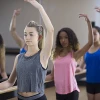62 careers found.
Actors portray roles in live and recorded or filmed productions. An actor may perform in theatre, opera or variety, film, radio, television, commercials and online material.
Art therapists work with a client or a group of clients to help them address emotional and psychological issues through creative activities such as drawing, painting, sculpting and collage.
Artists conceive and create visual representations to investigate, respond to or communicate an impression or idea.
Arts administrators manage artistic and cultural venues such as theatres and art galleries.
Body artists decorate or modify the bodies of their customers using techniques such as tattooing and piercing. While some body artists perform a combination of these techniques, it is not uncommon for a body artist to specialise in one area, such as tattooing or piercing.
Cartographic technicians assist cartographers with the analysis of field survey and land management data, aerial photographs and other geographic information sources to prepare maps, plans, charts and diagrams.
A craftsperson designs, makes and repairs objects that have both functional and artistic qualities, working with wood, metal, glass, leather, ceramics, textiles and other materials.
Cultural heritage officers are involved in the identification, assessment, conservation and interpretation of places and objects that have cultural heritage value.
Dancers are performers who entertain audiences by dancing as soloists, with a partner or as members of a group. There are many styles of dance, including ballet, contemporary, Aboriginal and Torres Strait Islander, folk, jazz, ballroom and tap. Dancers may perform using a variety of styles, or they may specialise in one particular dance style.
Engravers cut letters, figures and designs on metal, glass, wood, rubber, plastic and other surfaces.
Entertainers captivate, amuse or thrill an audience with dramatic, musical and other performances. They may perform a variety of tasks depending on their area of expertise.
Film and television camera operators set up, position and operate equipment in studios or on location to photograph or record people, events and scenes. Film camera operators use 16mm and 35mm film cameras or digital video for motion pictures, whereas television and video camera operators use cine-electronic television or digital video and video cameras for direct telecast and recording.
Film and television editors edit and assemble films and videos from raw, unedited footage ('dailies' or 'rushes'), taking into account the mood, pace and climax of films or television productions.
Film and television lighting operators position, set up and operate lighting equipment to light sets or studios during stage performances, television broadcasts or film productions. Film and television lighting operators are responsible, both creatively and technically, for lighting interior and exterior scenes and must achieve desired effects through the placement, intensity and colour of lighting.
Film and television producers' assistants provide technical and other assistance for the production, recording and/or broadcasting of artistic performances, news, sports and special events.










